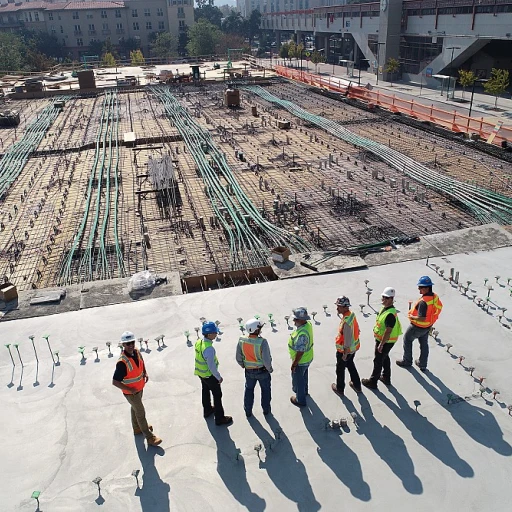Understanding the Link Between Retention and Career Development
The Connection Between Growth Opportunities and Staying Power
Understanding why employees stick around or decide to leave a job can often hinge on one critical point: career growth opportunities. Employee retention isn't just a fancy HR term. It's a real deal that impacts everything from an organization’s culture to its bottom line.
Imagine you're an employee looking for a long-term gig that adds value to your life. The way employees feel about their growth prospects plays a pivotal role. Those who sense that their career paths are stagnant might seek greener pastures.
Here's a straight talk: opportunities for advancement and employee engagement are interlinked. When people feel valued and see a clear trajectory for progression, organizations witness higher retention rates. This is not rocket science, just a basic human desire to grow and advance.
Professional development programs that effectively engage employees can lead to a more motivated workforce. A company that invests in learning development, whether it's offering new skills training or supporting career advancement, shows it's committed to nurturing top talent. This investment is paid back with loyalty.
Remember, well-structured growth opportunities are essential for both the employee and the business. It's a win-win. Not only does an open career path lead to a satisfied workforce, but it also attracts new talent eager to immerse themselves in a thriving environment.
For businesses grappling with retention, consider delving into strategies that enhance employee retention in entry-level positions. Providing engaging opportunities right from the get-go is a solid step forward.
https://www.employee-retention.net/blog/strategies-to-enhance-employee-retention-in-entry-level-positions
Big names in talent management, like Josh Bersin, have underscored the significance of career development in keeping employees intrigued and engaged (source: Josh Bersin Academy). When you see the growth horizon, sticking around makes perfect sense. Employee engagement is the backbone that supports an organization's mission and purpose, driving both individual and collective success.
Identifying Career Development Needs
Spotting the Needs of Your Team
Getting a handle on what your employees need for their career development is a bit like figuring out what makes them tick. It's not just about promotions or fancy titles; it's about understanding their aspirations and how they fit into the bigger picture of your company. When employees see a clear path for growth, they’re more likely to stick around. This is where employee engagement and retention go hand in hand.
Take a moment to chat with your team members about their career goals. It’s amazing what you can learn when you open up the floor for honest conversations. These talks can reveal a lot about their interests and how they envision their future within the organization. Remember, it’s not a one-size-fits-all approach. Each employee has unique skills and aspirations, and recognizing this diversity is key to fostering their development.
Tools to Gauge Development Needs
So, how do you get this valuable insight? Here are a few tools that can help:
- Surveys and Feedback Forms: Anonymous surveys can encourage employees to share their thoughts on career growth opportunities. Ask about their satisfaction with current development options and what they’d like to see more of.
- Performance Reviews: These aren’t just for evaluating past performance. Use them as a chance to discuss future goals and the skills needed to achieve them.
- One-on-One Meetings: Regular check-ins can provide a comfortable space for employees to express their career aspirations and any hurdles they might be facing.
Listening to Your Employees
Listening is more than just hearing words; it’s about understanding and acting on what your employees are saying. When people feel heard, their engagement and loyalty to the company often increase. This is crucial for long-term retention. As management, showing that you value their input by implementing changes or providing opportunities based on their feedback can make a world of difference.
Remember, identifying these needs is not just a task for the human resource department. It’s a collective effort that involves everyone from top management to team leaders. By fostering a culture of open communication and continuous learning, you create an environment where employees feel valued and motivated to grow with the company.
Implementing Effective Career Development Programs
Launching Career Development Programs that Work
Implementing effective career development programs can significantly support employee retention. When employees feel valued and see potential for career growth within their current organization, they're more likely to stick around. Here’s how you can set up such programs:
- Assess Employee Needs: Identify what your employees are really looking for in their careers. Is it more training, opportunities to take on new roles, or skill enhancement? Honest discussions and surveys can help pinpoint these needs.
- Create a Comprehensive Framework: Develop a structure that caters to various career paths in your organization. This framework should outline clear progression opportunities and advancement paths, enabling employees to visualize their future with your company.
- Multifaceted Training Opportunities: Incorporate different modes of learning. Online courses, workshops, and seminars can suit diverse learning styles and needs, keeping employees engaged in their development.
- Integrate Regular Feedback Mechanisms: Regular appraisals and feedback sessions encourage an open dialogue about an employee’s growth and development. This process not only enhances the employee-manager relationship but also aligns development goals with business objectives.
For a deeper understanding of how leadership can propel retention initiatives, see how
effective leadership drives employee retention.
- Encourage Internal Mobility: Promote a culture where employees feel knowledgeable and motivated enough to explore different roles within your organization. Internal mobility not only enhances employee skill sets but also benefits the company through a versatile talent pool.
To move forward, it's crucial that the programs don't become stagnant. Continuous improvement of these strategies based on feedback and industry trends will ensure they remain effective and relevant. In this way, businesses turn employee development into a winning strategy for everyone involved.
The Role of Mentorship in Career Growth
Nurturing Career Growth with Mentorship: A Path to Success
Mentorship plays a pivotal role in supporting employees through their career development journey. It's more than just a passing of knowledge; it is a relationship built on trust, guidance, and mutual growth. When businesses invest in mentorship programs, they're fostering an environment that encourages their employees to flourish and discover new career paths.
One striking feature of mentorship is the personalized attention it offers. While training and formal learning sessions provide broad knowledge, having a mentor lends a personal touch to the employee's professional development. A mentor can pinpoint areas where the mentee might need enhancement, suggest development opportunities, and help them navigate challenges they might face along their prospective career path.
A mentor acts like a seasoned guide who shares their personal experiences and stories of triumphs and tribulations. This real-world insight isn't something you can pick up from a textbook. For example, imagine an employee who is keen on developing leadership skills meeting regularly with a mentor who has already walked that path. Their interactions can spark growth, not just in terms of acquiring new skills but also boosting the employee's confidence and opening their eyes to new possibilities.
Organizations often match mentees with mentors inside their own company, thus ensuring that employees gain insights relevant to their current work environment. But the benefits extend beyond the walls of an organization. Networking opportunities through mentorship relationships are plentiful, fostering relationships that continually advance the careers of both mentors and mentees.
When employees feel supported and see a clear path for advancement, their engagement and retention improve. A strong testament to this is the connection between mentorship programs and the retention of top talent. According to a study by Deloitte, 68% of millennials say mentorship plays a key role in keeping them engaged at work. Investing in mentors can be a game-changer for human resources professionals tasked with fostering employee engagement and retention.
Through mentorship, companies can create a thriving workplace where employees feel valued and supported. It's a long-term strategy that pays dividends in the form of strong employee relationships, greater talent retention, and an environment where employees feel engaged and satisfied with their career advancement opportunities.
Measuring the Impact of Career Development on Retention
Measuring Career Development's Impact on Staying Power
Quantifying how career development influences employee retention can feel like catching lightning in a bottle. Yet, it's a crucial task to understand if our efforts morph into tangible benefits. Let's break down the key aspects to keep an eye on.
Tracking engagement is your starting point. When employees see clear career paths before them, their motivation ticks upwards. Surveys and feedback reveal whether initiatives like professional development sessions or skill-building workshops actually resonate. Are employees excited? Is that excitement translating into work and growth?
Performance metrics offer another lens. As employees develop new skills, you can expect a positive shift in job performance. It’s like planting seeds – watch them flourish into better results, which is never a bad thing for business. Keep an eye on parameters like productivity spikes, the quality of work, and innovation stemming from increased knowledge.
Next up, employee retention rates. There's no beating around the bush here – if career development opportunities are hitting the mark, fewer people will want to jump ship. You'll notice longer tenure and higher retention across departments. Look into comparing retention numbers before and after implementing development strategies.
Don't underestimate the power of talent management analytics. When used wisely, they’ll highlight unmissable patterns. Spot trends about top talent sticking around and gauge the effectiveness of current development offerings. It creates a feedback loop – apply findings to refine and bolster your programs further.
In it all, open communication stands out. Regular chats with employees offer insights better than any spreadsheet could. People want to feel heard and valued regarding their career growth. Learn directly from your team about what works or what might need a revamp.
Taking the pulse on career development programs is an ongoing exercise. By evaluating their impact, you're not just tallying numbers – it's about understanding how these opportunities shape employee development, retention, and long-term engagement. With accurate insights in hand, organizations can ensure they’re steering their teams toward fulfilling and lasting careers.
Overcoming Challenges in Career Development and Retention
Conquering the Hurdles of Career Growth for Employee Retention
When it comes to enhancing employee retention by tapping into career growth opportunities, there are bound to be some stumbling blocks that businesses and organizations might encounter. Let's talk about some of the common challenges and how these can be tackled, ensuring that employees feel their growth and development are taken seriously.
Firstly, one major obstacle is a lack of effective communication between management and employees. Employees should feel like they have a clear path to express their aspirations and career development needs. This can be remedied by setting up regular one-on-one meetings or feedback sessions where employees can voice their goals and concerns. Open dialogue fosters a sense of being valued, directly impacting employee engagement and retention.
Another challenge businesses face is offering tailored learning and development opportunities while considering limited resources. Not all organizations might have the budget for comprehensive training programs, but there are creative ways to offer professional development. Online courses and webinars, for instance, can provide flexible learning paths for employees keen on advancing their skills. Organizations could also consider internal training sessions facilitated by experienced colleagues, which can be an economical way of sharing knowledge.
Additionally, organizations sometimes struggle with identifying clear career paths for their employees. This issue often arises from inadequate talent management strategies. To counter this, businesses can create and communicate detailed career pathing plans. Providing a roadmap for career advancement keeps employees motivated by showing them what they need to achieve to progress within the company.
Finally, it’s crucial to recognize that change can be met with resistance. Some employees may be hesitant to engage with new development programs out of concern for overwhelming workloads or skepticism about the benefits. Management should strive to foster an environment where employees understand the value of such opportunities for personal and professional growth.
By navigating these challenges with empathy and thoughtful strategies, businesses can significantly boost employee engagement and ensure they retain their top talent for the long haul. Effective talent management and a commitment to genuine career growth will pave the way for a thriving workforce.













